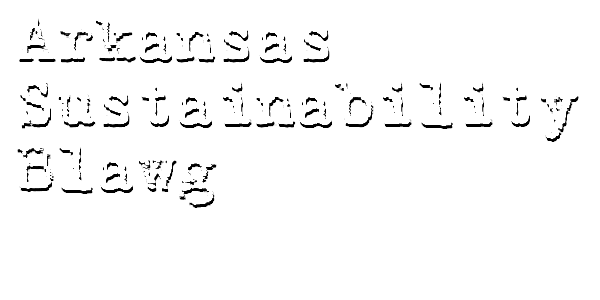Arkansas State University, Jonesboro, will host the 2011 Arkansas Renewable Energy Conference next Monday, April 18, 2011. This annual event is an important clearinghouse for all things renewable energy in Arkansas, and thus far there are over 125 registered attendees. While the focus of the conference is on research and development advances and opportunities, the undercurrent of much of the conference program is the continuing growth of the renewable energy and sustainable business economy in Arkansas. Here is the conference agenda:
8:00 am REGISTRATION AND BREAKFAST Alumni Lounge
Session I: Moderator: Paresh Patel
8:30 am Lynita Cooksey, Associate Vice Chancellor for Academic Services, ASU
Welcome
8:35 am Gregory Phillips, Dean, College of Agriculture and Technology, ASU
Overview of Renewable Energy activities at ASU
8:45 am Peter Nelson, Director, AgBio Works and Co-Founder of Biodimensions Inc, Memphis, TN
Photosynthesis: Economic Driver for Energy, Fuels, and Chemicals in the Mid-South
9:10 am Frank Kelly, President, Solar Source Consulting and Chairman, Arkansas Renewable Energy Association, Little Rock, AR
From Passive to Active. Why Design With the Sun in Mind?
9:35 am Gibson (Sunny) Morris, Arkansas Delta Training and Education Consortium (ADTEC), West Memphis, AR
ADTEC- The Power of Partnerships = The Power of Success!
10:00 am Benjamin Brenner, Sustainability Attorney, William & Anderson PLC, Little Rock, AR
Recent Developments in Renewable and Clean Energy Law in Arkansas: A Short Course on What Did and Did Not Happen in the Last Session of Arkansas' General Assembly
BREAK 10.25 – 10.45 pm Alumni Lounge
Session II: Moderator: Rajesh Sharma
10:45 am Mark Cochran, Vice President for Agriculture, University of Arkansas Division of Agriculture, Little Rock, AR
An Overview of UA Division of Agriculture Research and Extension Programs in Bioenergy
11:10 am Dan McDevitt, Vice President, Operations, Nordex USA Inc., Chicago IL
US Wind Industry: Challenges and Opportunities
11:35 am R. Paneer Selvam, Director of Computational Mechanics Laboratory, University of Arkansas, Fayetteville, AR
Solar thermal energy conversion and energy storage work at the University of Arkansas
12:00 am Mr. Omar Mendoza, US Air force
USA/DOD Renewable energy initiatives
LUNCH 12.25 – 2.00 pm Centennial Hall
Session IV: Moderator: Robert Straitt
2:00 pm Rajesh Sharma, Renewable Energy Technology Program, Arkansas State University, Jonesboro.
Photo-electrochemical Hydrogen Production
2:20 pm Robert Engelken, M. Jason Newell, Maqsood Ali Mughal, ShyamThapa, Joshua Vangilder, John Hall, Frederick Felizco, Zachery Hill, and David McNew, Arkansas State University Optoelectronic Materials Research Laboratory, Electrical Engineering and Environmental Science Program, Arkansas State University, Jonesboro.
NASA, NSF and NIH-funded photovoltaic/optoelectronic materials research at Arkansas State University
2:40 pm Kwangkook Jeong and Brad Edgar Center for Efficient and Sustainable Use of Resources, Department of Mechanical Engineering, Arkansas State University, Jonesboro.
Advanced concentrating solar power plant technologies and experimental and computational approach for novel molten salts development
3:00 pm Robert Straitt1, Nadine Straitt2 and Walter Ellis3, 1Resource Efficiency Manager, Little Rock Air Force Base (LRAFB), Little Rock, 2Arkansas State University, Jonesboro, 3Consultant, Washington DC.
Renewable Energy Systems for Families and Communities in Developing Regions
BREAK 3:20 – 3:40 pm
Session V: Moderator: Gauri Guha
3:40 PM Paul Armah, Professor of Agricultural Economics, College of Agriculture and Technology, Arkansas State University, Jonesboro.
The Economic Impact of Crude Oil and Ethanol Prices on Arkansas Livestock Feed Prices
4:00 pm Brett J. Savary1,2*, Prasanna Vasu1, Jose C. Tovar1 1Arkansas Biosciences Institute and 2College of Agriculture, Arkansas State University, Jonesboro, AR
Biochemical technologies for generating value co-products from plant biomass processing residues
4:20 pm Steve Green, Associate Professor, College of Agriculture and Technology. Arkansas State University-Jonesboro
Towards Sustainability in Biomass Energy Crop Production
4:40 pm Chris Barnoud, Renewable Energy Instructor, Mid-South Community College, West Memphis, AR
Biomass to Bio-based Products in the Champagne-Ardenne Region of France
5:00 pm Gregory Phillips, Dean, College of Agriculture and Technology, ASU
Concluding remarks
5:10 pm Conference adjourns
There will also be a “poster session” during the lunch hour.
For more information on the conference, contact Dr. Paresh Patel or Dr. Rajesh Sharma at ASU – Jonesboro.
(Department of Shameless Self-Promotion: This sustainablawger will be presenting at the conference on recent developments on renewable and clean energy law in Arkansas.)

